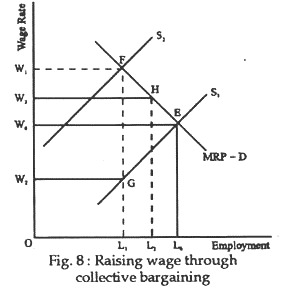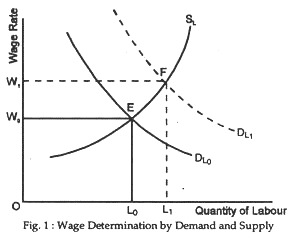Get the answer of: Under What Circumstances can a Trade Union Raise?
In a highly competitive labour market, an individual worker is by definition powerless to set the wage rate or improve the conditions of employment. A worker who demands a higher wage may be turned down in favour of other workers willing to accept less. Historically, unions have been used as an important means of increasing workers’ economic power. Union power has to be analysed in terms of supply, demand and marginal cost of labour.
Using Union Power to Raise Wages:
In a large and competitive labour market, the individual worker is an insignificant part of the total labour supply, with no power to influence his wage. His withdrawal from the labour market imposes no cost on employers, who can easily replace him at the competitive wage rate.
If a large group of workers acts collectively, however, it can impose substantial costs on employers. Through strikes and picketing, a group can reduce the available supply of workers significantly, forcing employers to cut back production and thereby restricting sales. Thus, employers have an incentive to pay attention to union demands.
ADVERTISEMENTS:
Fig. 8 shows how unions use their collective power to restrict the labour supply in bargaining for higher wages. In a competitive labour market without unions the supply of labour will be S1, the market wage rate w1, and the number of workers hired L2.
In a unionised labour market, where some workers cannot work because they are not union members, the supply of labour will be restricted to L2. The shift in the labour-supply curve will push the wage rate up to w2 and reduce the number of workers hired to L1. Beyond L2, each additional unionised worker costs more than he is worth to the employer.
If the labour market is controlled by a single employer or employer cartel, as in a professional game like football, a union can raise the wage without affecting the number of workers hired. As shown in Fig. 1, the monopsonistic firm will tend to hire L1 workers at a wage of w1, even though it could justify paying as much as w3 on economic grounds. Thus, through strikes or the threat of a strike, unions can raise the wage rate up to w3 without reducing employment. Only if the wage rate rises above w3 will the number of workers hired fall.
If the wage rate settles somewhere below w3—say at w2—the number of workers hired will actually increase, to l2 in Fig. 9. In such cases the union wage rate becomes the firm’s marginal cost of labour. No longer does the marginal cost of labour curve slope upward. Rather, it is horizontal at wage rate w2.
As in a non-unionised market, the monopsonist will hire up to the point where the marginal cost of labour, now constant at zv2, equals its marginal value, as shown by the demand curve. That point is L2. Minimum wage laws will have the same effect when imposed on monopsonistic labor markets.
As long as the minimum wage is fixed below 103 in the figure, employment will expand. Once the new employment equilibrium of w2L2 has been reached, however, further increases in the wage rate will reduce the employment level, unless they are accompanied by an increase in labour demand. For instance, if the wage rate were raised again from w2 to w3, employment would fall back from L2 to L1.
Because of these effects, the economic argument for unions and minimum wage laws is most powerful when employers enjoy significant monopsony power. Indeed, we should expect to find the most successful unions in monopsonistic labour markets. In competitive markets, where union wage demands are restricted by their adverse effects on total employment, unions will be less powerful. Moreover, the overall effect of minimum wage laws has been found to be negative; they have reduced employment.
ADVERTISEMENTS:
A second way unions can improve their members’ employment opportunities is by increasing the demand for their services either by supporting (politically) trade restrictions on foreign substitute goods or by promoting union-made products and services.
If they can increase demand for their products through advertising or lobbying, product prices will go up, and so will the demand for labour In Fig. 9 an increase in the demand for labour from D1 to D2 boosts the wage rate from w1 to w2. Unionised garment workers promote union-made clothing and automobile workers’ unions lobby for increased government spending on highways in order to increase the demand for their products.
Union efforts to not necessarily increase employment for all workers An increase in government expenditures on aircraft, for instance, can mean less spent on educational programmes and hence fewer teachers hired The expenditure could be funded through a tax increase, which would reduce spending on consumer items like furniture and houses, depressing employment in those industries. All in all, union efforts to increase employment probably distort employment opportunities more than they improve them.
The Efficiency of Unions:
Our analysis of union power presumes that unions are sufficiently large and well-organised to affect the labour supply by striking. In a free and open market, however, taking collective action can be difficult, particularly when the labour market is large and the use of force is prohibited by law Non-union workers will tend to free-ride on unions’ efforts to improve wages.
If the union restricts the labour supply, it provides benefits (a public good) to all of the workers in that labour market. However, only union workers bear the cost of establishing those restrictions through organising paying dues, and striking.
Like cartelisation, collective action is much more likely to succeed in small groups than in large ones. In a small union, where each worker is a significant part of the total labour supply, individual members can see direct benefits from them. In small groups, ties of friendship strengthen bonds based on economic need, discouraging free riding.
Workers in such settings are therefore more likely to be willing to bear the costs of union membership In fact; unions first emerged in small-group settings, where employer and employee worked together closely. Later small unions were organised into federations that could offer members special benefits, such as insurance policies and recreational facilities.
Large unions developed last, largely because a worker in a large group represents only a small fraction of the total labour supply. Just as an individual worker’s withdrawal from the market would have no detectable effect on the labour supply or wage rate, his contribution to a strike that secures a wage increase will never be noticed.
ADVERTISEMENTS:
The result would be the same with or without his participation in the movement. Workers in a large labour market may not have enough incentive to take on the costs involved in participating in a union movement.
For this reason the threat of force is common in many large union movements. Workers who cross a picket line may suffer personal injury or social ostracism. Individual workers must weigh the cost of not participating in the union (physical injury or property damage) against the cost of participating (union dues, or lost wages during strikes).
The cost of not participating can be so great that membership even in a large union becomes a rational act. Of course, employers have used the same tactics to discourage union membership. The history of the labour movement has been rocky at best, replete with criminal acts by both owners and labour organisers.
Union and state laws also support union organising efforts. If a simple majority of workers vote for unionisation, their plant or firm can be organised as a union shop. A union shop is a place of employment where a worker, once employed, must join the recognised union as a condition of continued employment. If a new worker refuses to join the union, he is simply denied employment in that firm. Thus, the government imposes a substantial cost on workers who do not participate in union activities.
ADVERTISEMENTS:
While the institution of democratic elections has greatly reduced the potential for violence in such situations, it has also reduced the cost of organising a union. Unions argue that compulsory membership through democratic elections (the union shop) is necessary to overcome the free- rider problem.
Although unions may be seen as a welcome counterforce to the market power of large, successful, employer cartels, they can have negative effects as well. Just as union members have an interest in keeping each other from accepting a lower wage (because the result of ensuing competition will be lower wages for all); they also have an interest in keeping any individual from improving his skills.
If some workers compete by improving their productivity, all may have to follow suit. To reduce such competition among workers, unions typically seek wage schedules that are not based on job performance. In most unions, wages are based on seniority, and wage increases are distributed equally across the board.
To the extent that hard- work and improved skills are not rewarded in a union shop, unions contribute to production inefficiencies. Union leaders try to counter this trend by ensuing that unions increase productivity by fostering workers’ self-esteem and sense of control over their economic well-being.


